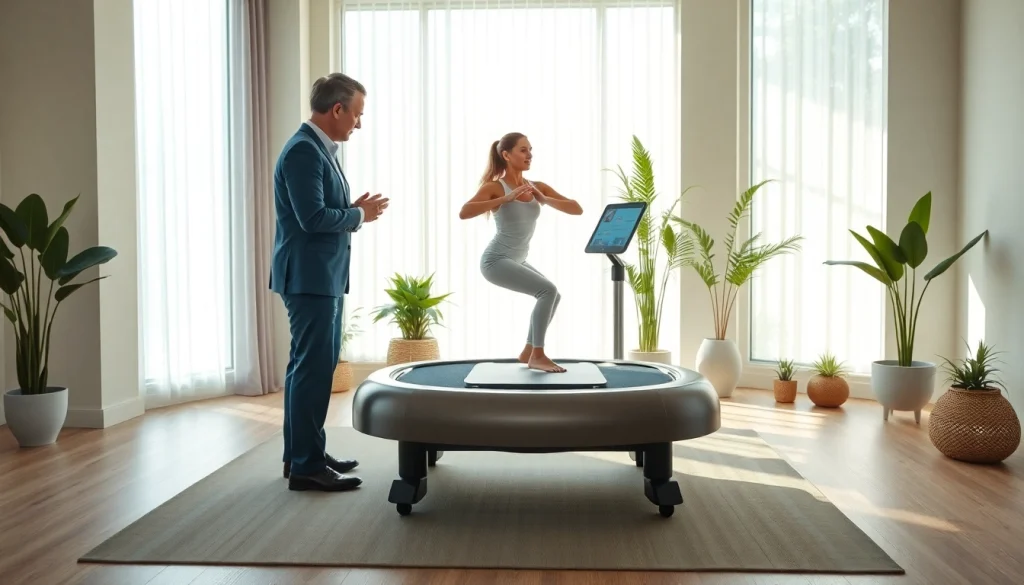Benefits and Insights on Whole Body Vibration Therapy for Wellness

Understanding Whole Body Vibration Therapy
What is Whole Body Vibration Therapy?
Whole body vibration therapy (WBV) is a form of exercise that utilizes mechanical vibrations to stimulate the human body. Patients stand, sit, or lie on a platform that vibrates at specific frequencies. This technique originated in the 1960s for athletic training and rehabilitation, and it now garners attention for various health benefits. During the treatment, the vibration generates energy that stimulates muscles to contract and relax rapidly. This passive form of exercise can assist individuals who may have difficulty with traditional forms of physical activity.
How Does Whole Body Vibration Work?
Whole body vibration therapy operates on the principle of whole body vibration therapy, where the user stands, sits, or reclines on a vibrating platform. As the machine vibrates, it sends energy throughout the body, inducing involuntary muscle contractions. Depending on the frequency and amplitude of the vibrations, users may experience variations in muscle tension and tone. This mechanical stimulation can enhance muscle recruitment, increase blood flow, and improve circulation, mimicking effects comparable to traditional exercise.
Physiological Effects of Whole Body Vibration
Research indicates that WBV therapy can lead to numerous physiological benefits, such as:
- Enhanced Muscle Strength: Studies suggest that WBV can promote significant strength gains, particularly in older adults who experience age-related muscle atrophy.
- Improved Flexibility: Regular WBV can aid in enhancing muscle flexibility and joint mobility due to its dynamic muscle engagement.
- Increased Bone Density: WBV therapy may stimulate bone formation, offering protective benefits against osteoporosis and fractures.
- Cardiovascular Health: Some research shows that WBV can improve cardiovascular health by potentially lowering blood pressure and enhancing circulation.
- Pain Management: WBV may provide relief for chronic pain conditions, such as fibromyalgia, by reducing muscle tension and improving circulation.
Potential Benefits of Whole Body Vibration Therapy
Improvement in Muscle Strength
One of the primary benefits of whole body vibration therapy is the improvement in muscle strength. Studies have shown that consistent use of vibration platforms can enhance muscle performance. For example, elderly subjects have demonstrated increased lower limb strength after engaging in WBV therapy sessions. This makes WBV an appealing alternative for individuals with limited mobility or those recovering from surgery.
Enhancement of Flexibility and Balance
Another noteworthy benefit of WBV is its role in enhancing flexibility and balance. The rapid muscle contractions lead to improved coordination and proprioception, essential for maintaining balance, especially in older adults. It is often recommended as a preventative measure against falls, helping to stabilize individuals who may be at risk due to age or existing conditions.
Pain Management through Whole Body Vibration Therapy
Whole body vibration therapy has emerged as a potential therapeutic option for pain management. The mechanical stimulation provided by the vibrating platform may help alleviate chronic pain conditions, enhance recovery post-exercise, and reduce muscle fatigue. Anecdotal evidence suggests individuals with conditions such as arthritis benefit from reduced joint pain and inflammation following regular WBV sessions. This approach allows many to incorporate physical activity into their lives with less discomfort.
Guidelines for Safe Implementation
Identifying Suitable Candidates for Whole Body Vibration Therapy
Whole body vibration therapy is not universally applicable; hence, identifying suitable candidates is essential. Ideal candidates include:
- Individuals seeking rehabilitation post-injury.
- Older adults aiming to improve muscle strength and balance.
- People with mobility impairments who struggle with conventional exercise forms.
- Athletes looking to enhance performance and recovery.
However, individuals with specific medical conditions or concerns should consult healthcare professionals before beginning therapy.
Safety Precautions and Contraindications
Safety is paramount in every therapeutic approach, including whole body vibration therapy. Some contraindications may include:
- Pregnancy
- Cardiovascular issues
- Severe migraines or headaches
- Hip or knee replacement surgeries
- Uncontrolled hypertension
Therapists must evaluate each individual case, ensuring that those with health concerns proceed with caution.
Best Practices for Effective Sessions
To maximize the benefits of whole body vibration therapy, practitioners can adopt the following best practices:
- Begin with shorter sessions and gradually increase duration as tolerated.
- Incorporate various positions (sitting, standing, or in a squat) to engage different muscle groups.
- Maintain an appropriate frequency and amplitude based on personal fitness levels and goals.
- Consult professionals who specialize in WBV for tailored individual plans.
Comparative Analysis with Traditional Therapies
Whole Body Vibration Compared to Traditional Exercises
Compared to traditional exercise modalities, whole body vibration therapy has unique advantages. While conventional exercises require active engagement and muscle exertion, WBV provides a more passive form of exercise. For individuals unable to perform high-intensity workouts, WBV can still stimulate muscle activity, thus offering an option for those with restrictions.
Effectiveness Against Other Treatment Modalities
In the realm of physical rehabilitation and therapy, whole body vibration therapy plays a complementary role. Studies suggest that combining WBV with conventional treatments, such as physical therapy or strength training, enhances recovery compared to singular approaches. Additionally, the immediate effects of vibration therapy can often result in pain relief, aiding traditional therapies significantly during initial recovery phases.
Patient Experiences with Whole Body Vibration Therapy
Many patients express positive experiences from whole body vibration therapy. Reports highlight improved overall well-being, including enhanced mood, reduced discomfort, and increased willingness to engage in more physical activities following their sessions. These subjective outcomes are as important as clinical results, demonstrating the therapy’s value in promoting not just physical, but mental health as well.
Future Trends in Whole Body Vibration Therapy
Innovations in Vibrating Platforms
The technological advancement in vibrating platforms is likely to continue evolving. Companies are developing more versatile machines, featuring adjustable frequencies, customizable programs, and even integration with wearable technology. Such innovations will enhance user experience and expand applications within both therapeutic and athletic environments.
Research Advancements in Whole Body Vibration Applications
Research on whole body vibration therapy continues to grow, focusing on broader applications, including cognitive function and mental health. Ongoing studies aim to uncover the underlying mechanisms that contribute to the therapy’s effectiveness, ultimately refining protocols and expanding knowledge surrounding its capabilities.
Long-term Outlook for Whole Body Vibration Therapy
The long-term outlook for whole body vibration therapy appears promising. As healthcare continues to evolve toward more holistic approaches, WBV may find its place alongside traditional treatments. With its ability to promote muscle retention, improve balance and stability, and aid in pain management, WBV represents a valuable tool in the pursuit of overall health and wellness.







